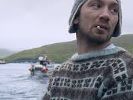Eye For Film >> Movies >> The Islands And The Whales (2016) Film Review
The Islands And The Whales
Reviewed by: Jennie Kermode

There are 18 of them altogether, clustered at 61.8926° N, 6.9118° W, inside the Arctic circle. Not all of them are inhabitable, but together they're home to some 49,000 people, making them the 21st smallest nation on Earth. But what is life actually like for the Faroese? Mike Day's documentary investigates at a time of flux, when tradition is being swept aside by the pressures of the modern age and locals are seeking ways of holding onto their cultural identity as they find that they are no longer able to depend on the sea.
For centuries, one of the Faeroes' mainstays was whaling. In respect of their economic dependence on it, and considering that they hunt pilot whales (whose overall population size is still relatively strong), special provision has been made for them in treaties clamping down on this activity. This film contains footage of whales being driven ashore and speared which some viewers may find acutely distressing. The locals are confused by activists who visit to disrupt such activity - prepared to listen, so it would seem, but struggling with the concept that the whales might have personhood, which is interesting in light of one islander's later befriending of a bird also generally considered to be a food item. It is not this, however, that threatens the continuation of whaling - rather, it's the high levels of mercury building up in the islanders' blood. And that should worry us all.

Their stomachs are full of plastic, a Faroese man tells us as he prepares gannets for sale. They didn't used to be like this. Other men discuss whether the fish population has really fallen as drastically as they think, joking that perhaps the mercury they're consuming has destroyed their short term memories. Children are, on average, a year behind in school for every doubling of the mercury level in their blood, a doctor tells us. Puffin meat, once a staple, is now off the menu because the population has collapsed so badly. There are no plankton so the base of the food chain has been swept away. Tall and windswept with thin soil, these are not islands on which very much can be grown. As Day documents these changes, the problems of whales and whalers begin to seem small.
It's often in the small things, though, that the magic of a film lies. The Islands And The Whales knows when to be small, and its intimate portraits of day to day life illustrate how the monumental intersects with the personal. Gently berated by his wife, one man tells us that he's going to keep on eating whale meet because he likes it and other people shouldn't tell him what to do. Others are cutting down but are bamboozled by the activists' suggestion that, ideally, they shouldn't be eating any kind of animal.
Day frames the film with one man's recollection of old stories about the huldufólk, the secret people once widely believed to inhabit the wild parts of the islands, who were traditionally cited as a source of wisdom on the management of the environment. Did they have a message for humans that was lost? The Faroese are not angels, we are reminded; they bear a share of responsibility for their plight. But here they seem very small, trying to hold out against tides that threaten to overwhelm them.
Reviewed on: 16 Nov 2016

















